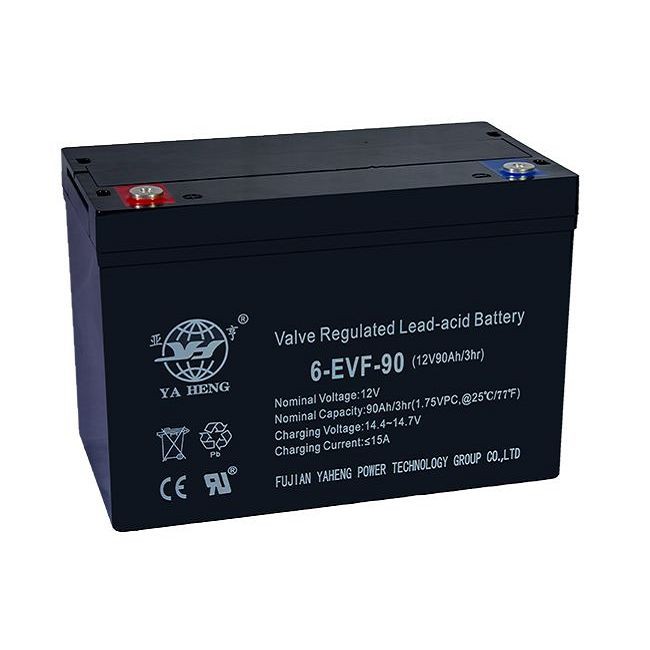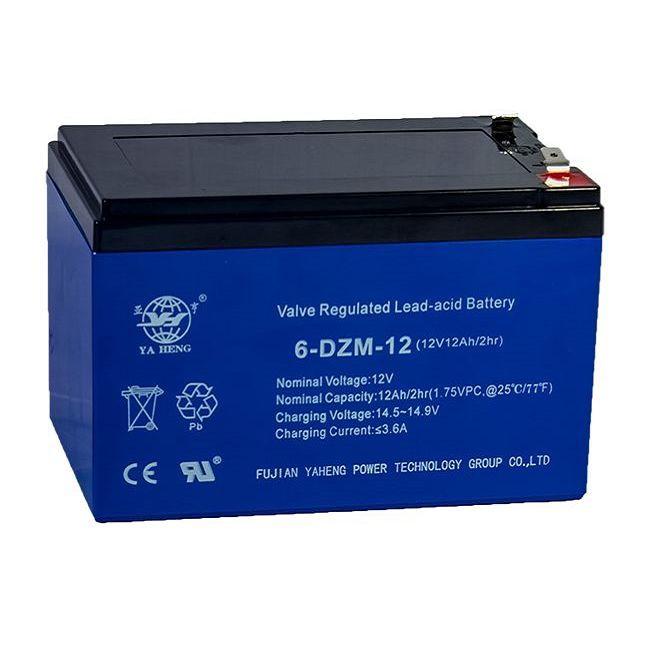Electric Vehicle Battery
Fujian Yaheng Power Technology Group Co., Ltd established in 1997, covers an area of 224000 m2. Yaheng Power is a professional sealed lead-acid battery and lead-acid battery machinery manufacturer. Yaheng Power Technology Group Co., Ltd is ISO9001, ISO 14001 certified company.We're known as one of the most professional electric vehicle battery manufacturers and suppliers in China.
-
E-bike BatteryYaheng started the EV battery business from 2003. More than twenty years experience in the VRLAAdd to Inquiry
-
Electric Motorcycle BatteryThe DZM series is a kind of EV battery, capacity at 2 hour rate. Motive power applications toAdd to Inquiry
-
Electric Golf Cart Battery12V32AH (6-EVF-32) EV battery is the most popular battery. The 6-EVF-32 battery 32AH/3HR. 12V32AHAdd to Inquiry
-
Wheel Chair Battery12V33AH (6-DZM-33) Wheel Chair battery is the most popular item for wheelchair.Add to Inquiry
-
Electric Wheel Chair Battery12V55AH (6-EVF-55) EV battery is the most popular battery. The 6-EVF-55 battery 55AH/3HR. 12V55AHAdd to Inquiry
-
Motivation BatteryCadmium free materialsGEL VRLA technologyRare earth MaterialLong cycle life batteryAdd to Inquiry
-
Electric Trolley Battery12V150AH (6-EVF-150) EV battery is the most popular electric Vehicle battery. The 12V150AH EVAdd to Inquiry
-
Electric Tricycle Battery12V200AH (6-EVF-200) EV battery, mainly designed for Washing machine, Cleaning machine, Camper, RVAdd to Inquiry
- Tel: +86-760-88625562
- Fax: +86-760-88625562
- Email: johny5@126.com
- Add: No.12 Ave.1 North, Industrial Rd. East, Guzhen, Zhongshan, Guangdong, China
Why Choose Us
R&D capabilities
There are 30 employees, some of whom have more than 30 years of experience in the battery industry, and have established a battery material laboratory in cooperation with a famous American university research and development institution. Yaheng has developed different chemical formulas according to the application.
Advanced equipment
With Yaheng automation equipment, Yaheng was the first in China to produce cast-welded batteries, combining mechanical equipment with material technology to shorten the battery development cycle.
Wide product lines
Yaheng batteries meet international standards and have a complete UPS, solar power generation system, telecommunications power system, motorcycle and electric vehicle product line, more than 300 models, 2V, 4V, 6V, 8V, 12V, 16V, 24V and 1.2AH~3000AH.
Accept ODM/OEM service
Our team of experts will work closely with you to understand your needs and will provide solutions that are tailored to meet your expectations.
Advantages of electric vehicle battery
Environmental benefits
Electric vehicle batteries are rechargeable and produce zero tailpipe emissions, making them a cleaner alternative to gasoline-powered vehicles. By transitioning to electric vehicles, we can significantly reduce air pollution and greenhouse gas emissions, helping combat climate change and improve air quality in our cities.
01
Charging flexibility
Electric vehicle batteries extensive range of charging alternatives stands as a key advantage. The versatile charging options for electric vehicle batteries aligns with everybody’s’ preferences and lifestyle. It can seamlessly draw power from standard home outlets, providing a convenient and accessible charging solution for daily use.
02
Energy efficiency
Electric vehicle batteries are highly efficient in converting stored energy into motion. They have higher energy conversion rates compared to internal combustion engines, resulting in better fuel economy and longer driving ranges. This allows electric vehicles to travel more miles on a single charge, reducing the need for frequent recharging.
03
Renewable energy integration
Electric vehicle batteries can play a crucial role in integrating renewable energy sources into the power grid. By utilizing smart charging technology, electric vehicles can charge during off-peak hours when renewable energy generation is high, reducing the strain on the grid and maximizing the utilization of clean energy.
04
Reduced dependence on fossil fuels
One of the main advantages of electric vehicle batteries is their ability to reduce our dependence on fossil fuels. As the world moves towards a more sustainable energy future, electric vehicles powered by renewable energy sources can help decrease our reliance on finite resources and enhance energy security.
05
Types of Electric Vehicle Battery




Lithium-Ion Batteries
Lithium-ion batteries are the most common type used in electric vehicles due to their high energy density, lightweight design, and long cycle life. They are known for providing a good balance between power and range, making them suitable for a wide range of EV applications.
Solid-State Batteries
Solid-state batteries represent a promising advancement in EV battery technology. They use solid electrolytes instead of liquid electrolytes found in traditional lithium-ion batteries. Solid-state batteries offer advantages such as higher energy density, improved safety, and faster charging times.
Nickel-Metal Hydride (NiMH) Batteries
Although less common in modern EV, nickel-metal hydride batteries have been used in earlier hybrid vehicles like the Toyota Prius. They are known for their durability, high energy density, and relatively lower environmental impact compared to some other battery types.
Sodium-Ion Batteries
Sodium-ion batteries have garnered attention as a potential alternative to lithium-ion batteries. They share similarities in design but use sodium ions instead of lithium ions. Sodium is more abundant and cost-effective than lithium, potentially addressing concerns related to resource availability.
Lithium-Iron Phosphate (LiFePO4) Batteries
Lithium-iron phosphate batteries are a subset of lithium-ion batteries known for their enhanced safety and thermal stability. They find applications in electric buses, power storage systems, and certain electric vehicles. While they may have a lower energy density compared to other lithium-ion variants, their durability and safety features make them attractive for specific use cases.
Zinc-Air Batteries
Zinc-air batteries use oxygen from the air to generate electricity by reacting with zinc. They are lightweight and offer high energy density, making them suitable for electric vehicles.
Graphene Batteries
Graphene batteries utilize graphene, a single layer of carbon atoms arranged in a hexagonal lattice, as a key component. These batteries are known for their high conductivity, fast charging capabilities, and potential for high energy density.
Hybrid Capacitor Batteries
Hybrid capacitor batteries combine features of both traditional lithium-ion batteries and capacitors. They offer high power density, enabling rapid charging and discharging, making them suitable for applications where quick bursts of energy are required.
Parameter
|
Cells Per Unit |
6 |
|
Voltage Per Unit |
12 |
|
Capacity |
20AH@2hr-rate to 1.75V per cell @ 25℃ |
|
Weight |
Approx.6.9 kg (Tolerance±3%) |
|
Max. Discharge Current |
200 A(5sec) |
|
Internal Resistance |
Approx 28 mΩ |
|
Operating Temperature |
Discharge: -20℃~60℃ Charge: 0℃~50℃ Storage: -20℃~60℃ |
|
Normal Operating Temperature |
25±5℃ |
|
Float Charging Voltage |
13.6 to 13.8 VDC/unit Average at 25 ℃ |
|
Maximum Charging Current |
6.0A |
|
Equalization and Cycle service |
14.6 to 14.8 VDC /unit Average at 25℃ |
|
Terminal |
F18 |
|
Container Material |
A.B.S. UL94-HB, Flammability resistance of Ul94-V2 can be avail upon request |
Battery module array: A battery module array refers to the energy storage components of a battery. They are grouped into modules, each containing a specific number of cells that are connected together by wires. These modules are then connected to form the final full-size battery pack.
Battery management system: The battery management system (BMS) of an electric vehicle is the most fundamental part of its battery. The BMS controls every aspect of the battery and ensures it operates optimally. For example, it will monitor and regulate the charge level of each cell, decide which cells to charge or discharge, and keep track of the temperature of the battery pack.
Battery electrical system: The battery electrical system refers to all the wiring, connections, fuses, and other electrical components needed to operate an electric vehicle battery. It is designed to withstand high voltages and is usually integrated with the battery management system to efficiently manage each cell.
Battery cooling system: Due to their large size, electric vehicle batteries generate a lot of heat that needs to be dissipated, which is the responsibility of the battery cooling system. Typically, it consists of a sealed coolant that draws heat away from the battery cells and dissipates it into the air.
Battery protection case: This is the protective casing for the battery cells that protects them from external factors and ensures their structural integrity. Electric vehicle battery enclosures are typically made of steel or aluminum for durability, impact resistance, and corrosion resistance. The enclosure’s design will also contain cooling channels or vents to manage heat dissipation and maintain optimal operating temperatures.

Maintenance of Electric Vehicle Battery
Avoid extreme temperatures
Park in shaded or climate-controlled areas to protect the battery from extreme heat or cold.
01
Manage charge levels
Avoid consistently charging to 100% or letting the battery drop to 0%. Aim to keep the charge level between 20% and 80%.
02
Use fast charging sparingly
Frequent use of DC fast chargers can degrade the battery faster than slower AC charging.
03
Regular maintenance
Follow the manufacturer's maintenance guidelines to ensure optimal battery health.
04
Packaging and Shipping


Our Certificates






FAQ
We're well-known as one of the leading electric vehicle battery manufacturers and suppliers in China. Please feel free to buy high quality electric vehicle battery for sale here from our factory. For customized service, contact us now.
solar battery for powering water treatment equipment, solar battery for powering joysticks, overvoltage protection standby battery











